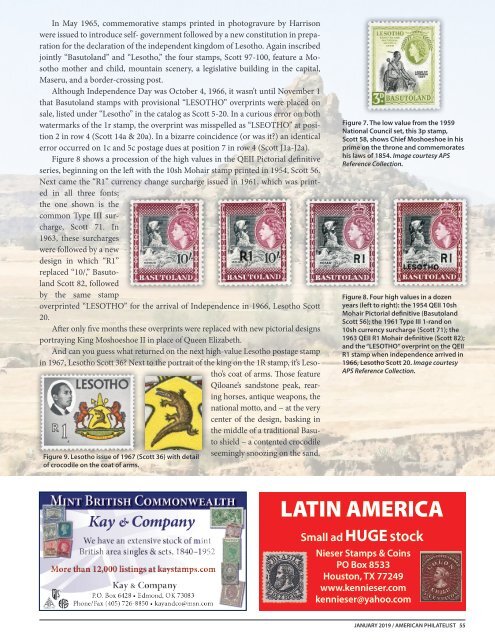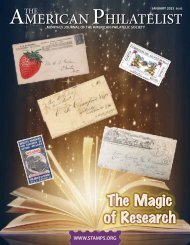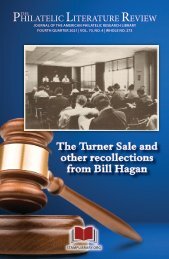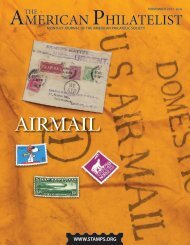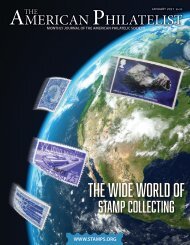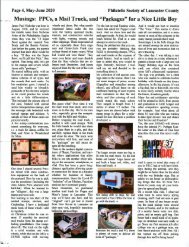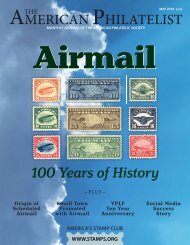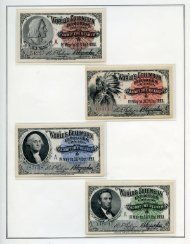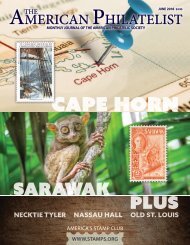January 2019
Create successful ePaper yourself
Turn your PDF publications into a flip-book with our unique Google optimized e-Paper software.
In May 1965, commemorative stamps printed in photogravure by Harrison<br />
were issued to introduce self- government followed by a new constitution in preparation<br />
for the declaration of the independent kingdom of Lesotho. Again inscribed<br />
jointly “Basutoland” and “Lesotho,” the four stamps, Scott 97-100, feature a Mosotho<br />
mother and child, mountain scenery, a legislative building in the capital,<br />
Maseru, and a border-crossing post.<br />
Although Independence Day was October 4, 1966, it wasn’t until November 1<br />
that Basutoland stamps with provisional “LESOTHO” overprints were placed on<br />
sale, listed under “Lesotho” in the catalog as Scott 5-20. In a curious error on both<br />
watermarks of the 1r stamp, the overprint was misspelled as “LSEOTHO” at position<br />
2 in row 4 (Scott 14a & 20a). In a bizarre coincidence (or was it?) an identical<br />
error occurred on 1c and 5c postage dues at position 7 in row 4 (Scott J1a-J2a).<br />
Figure 8 shows a procession of the high values in the QEII Pictorial definitive<br />
series, beginning on the left with the 10sh Mohair stamp printed in 1954, Scott 56.<br />
Next came the “R1” currency change surcharge issued in 1961, which was printed<br />
in all three fonts;<br />
the one shown is the<br />
common Type III surcharge,<br />
Scott 71. In<br />
1963, these surcharges<br />
were followed by a new<br />
design in which “R1”<br />
replaced “10/,” Basutoland<br />
Scott 82, followed<br />
by the same stamp<br />
overprinted “LESOTHO” for the arrival of Independence in 1966, Lesotho Scott<br />
20.<br />
After only five months these overprints were replaced with new pictorial designs<br />
portraying King Moshoeshoe II in place of Queen Elizabeth.<br />
And can you guess what returned on the next high-value Lesotho postage stamp<br />
in 1967, Lesotho Scott 36? Next to the portrait of the king on the 1R stamp, it’s Lesotho’s<br />
coat of arms. Those feature<br />
Qiloane’s sandstone peak, rearing<br />
horses, antique weapons, the<br />
national motto, and − at the very<br />
center of the design, basking in<br />
the middle of a traditional Basuto<br />
shield − a contented crocodile<br />
Figure 9. Lesotho issue of 1967 (Scott 36) with detail seemingly snoozing on the sand.<br />
of crocodile on the coat of arms.<br />
Figure 7. The low value from the 1959<br />
National Council set, this 3p stamp,<br />
Scott 58, shows Chief Moshoeshoe in his<br />
prime on the throne and commemorates<br />
his laws of 1854. Image courtesy APS<br />
Reference Collection.<br />
Figure 8. Four high values in a dozen<br />
years (left to right): the 1954 QEII 10sh<br />
Mohair Pictorial definitive (Basutoland<br />
Scott 56); the 1961 Type III 1-rand on<br />
10sh currency surcharge (Scott 71); the<br />
1963 QEII R1 Mohair definitive (Scott 82);<br />
and the “LESOTHO” overprint on the QEII<br />
R1 stamp when independence arrived in<br />
1966, Lesotho Scott 20. Image courtesy<br />
APS Reference Collection.<br />
LATIN AMERICA<br />
Small ad HUGE stock<br />
Nieser Stamps & Coins<br />
PO Box 8533<br />
Houston, TX 77249<br />
www.kennieser.com<br />
kennieser@yahoo.com<br />
JANUARY <strong>2019</strong> / AMERICAN PHILATELIST 55


